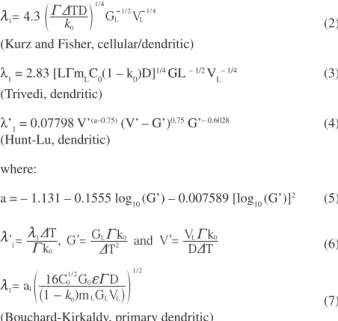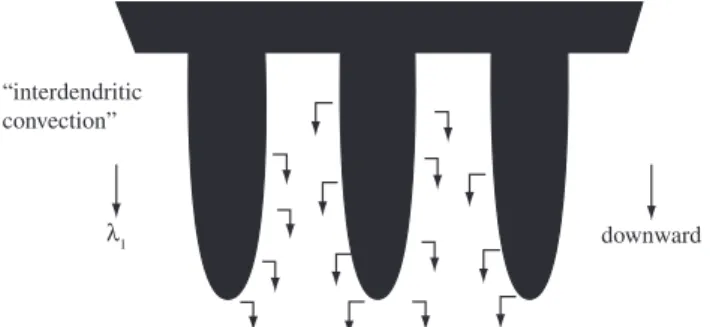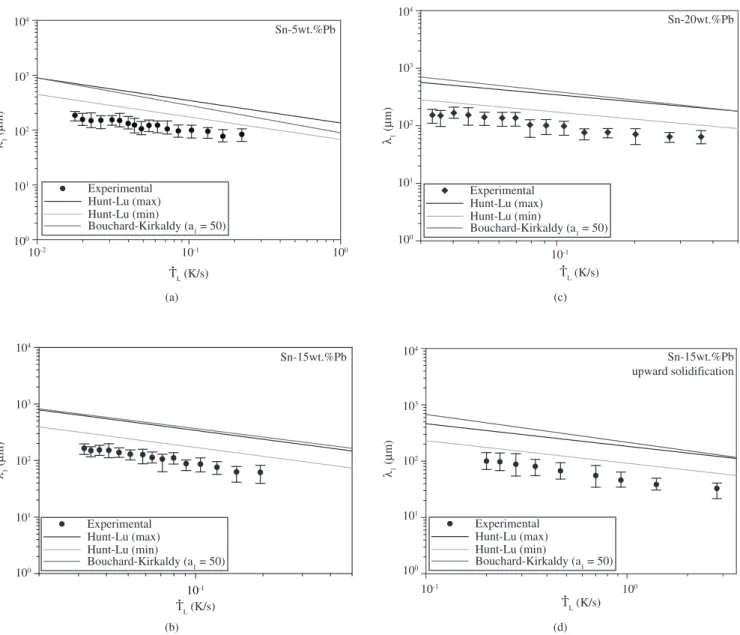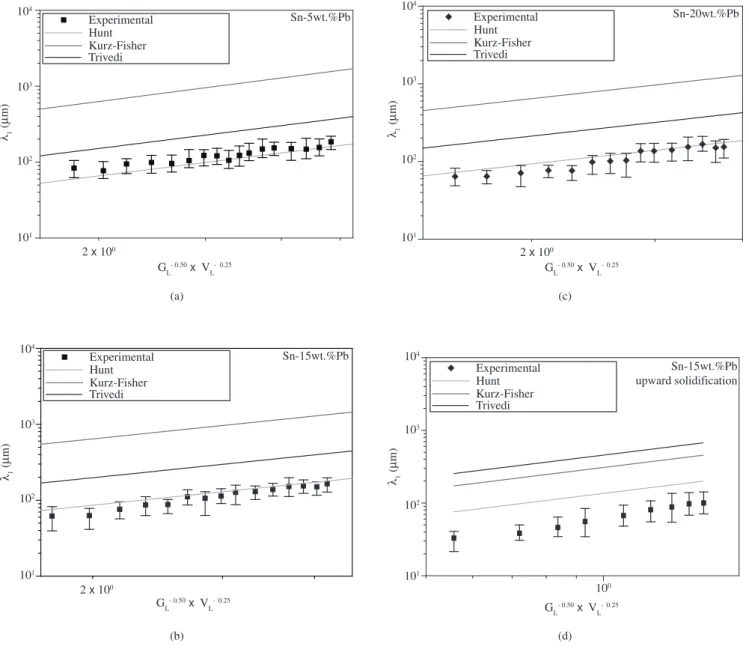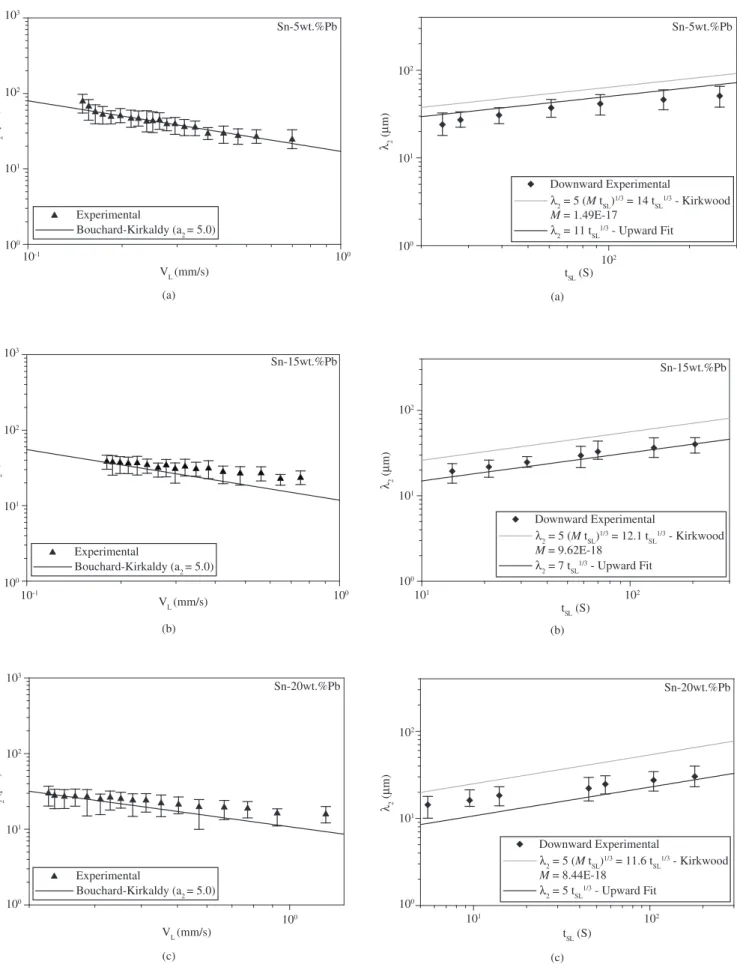*e-mail: amaurig@fem.unicamp.br
The Influence of Melt Convection on Dendritic Spacing of Downward
Unsteady-State Directionally Solidified Sn-Pb Alloys
José Eduardo Spinellia, Otávio Fernandes Lima Rochab, Amauri Garciaa*
a
Department of Materials Engineering State University of Campinas, UNICAMP,
P.O. Box 6122, 13083-970 Campinas - SP, Brazil
b
Federal Center of Technological Education – CEFET, Belém - PA, Brazil
Received: December 2, 2004; Revised: August 8, 2005
Microstructures are the strategic link between materials processing and materials behavior. A dendritic structure is the most frequently observed pattern of solidified alloys. The microstructural scales of dendrites, such as primary and secondary arm spacings, control the segregation profiles and the formation of secondary phases within interdendritic regions, determine the properties of cast structures. In this work, the influence of thermosolutal convection on dendrite arm spacings is experimentally examined in the downward vertical unsteady-state directional solidification of Sn-Pb hypoeutectic alloys. The experimental observations are compared not only with the main predictive theoretical models for dendritic spacings but also with experimental results obtained for Sn-Pb alloys solidified vertically upwards. Primary dendritic arm spacings have been affected by the direction of growth, decreasing in conditions of downward vertical solidification when compared with those grown vertically upwards. Further, the unsteady-state λ1 predictive models did not generate the experimental observations.
Keywords:downward unidirectional solidification, dendritic spacings, dendritic growth models, Sn-Pb alloys
1. Introduction
The fundamental understanding of the relationship between solidification variables and the resulting structure is essential for the development of improved methods for quality castings. Alloy solidification involves heat, fluid flow and the transport of solute, which influence the development of both the macrostructure and the microstructure. The prediction of these structures is of great interest for the evaluation and design of mechanical properties of castings.
Several theoretical models have been proposed in the literature to describe the dependence of primary and secondary dendrite arm spacings on solidification variables such as initial alloy composition, growth rate and thermal gradient1-8. Although convection effects
strongly influence on the development of solidification microstructure, the main theoretical dendritic models from the literature are based on purely diffusive transport mechanisms. In addition, recent articles on cellular9,10 and primary dendritic11 growth under unsteady-state
solidification conditions have shown that the predictive theoretical models existing in the literature did not generate the experimental observations.
Only a few studies have reported influences of interdendritic convection and direction of growth on dendrite arm spacings12-15.
Burden and Hunt13 have carried out solidification experiments with
the ammonium chloride/water system in order to investigate the effect of solute flow and direction of growth on primary dendrite arm spac-ings. In the case of downward growth, the lighter water-rich formed interdendritic liquid tends to flow upwards and fill the interdendritic space. In the upward growth the water-rich melt tends to flow into the bulk liquid. They have reported that primary spacings for downward growth were of an order of magnitude smaller than those observed for upward solidification. Hui et al. have reported a decrease of the mean primary dendritic spacing and a more disordered dendritic array caused by interdendritic convection during directional solidification of Pb-Sb alloys12.
When the solute is denser than the solvent, a denser solute-en-riched melt can be induced in the mushy zone and ahead of the growth interface. Under these conditions and considering upward vertical solidification (melt on top and solid below), it is expected that no natural convection occurs, since both the temperature and composi-tional gradients have a stabilizing effect on the density stratification. On the other hand, if a melt is cooled from the top, the fluid layer may become thermally unstable, and, hence, a thermal-buoyancy-driven flow occurs. Additionally, if the system has a denser interdendritic melt during downward solidification, the configuration leads to a situation where both thermal and compositional fields are unstable, and convective currents take place.
The main purpose of this article is to experimentally examine the influence of thermosolutal convection on dendrite arm spacings during the downward vertical solidification of hypoeutectic Sn-Pb alloys, to discuss the application of the main primary and secondary theoretical dendrite spacing models in the presence of convection during solidification and, at last, to analyze the dendritic growth for both upward and downward unsteady-state solidification systems.
2. Dendritic Growth Models
Among the theoretical models existing in the literature only those proposed by Hunt and Lu1 for primary spacings and
Bouchard-Kirkaldy2 for primary and secondary spacings assume solidification
in unsteady-state heat flow conditions. Hunt3, Kurz and Fisher4,5,
and Trivedi6 have derived primary spacing formulae, which apply
for steady-state conditions. The theoretical models for determina-tion of dendritic spacings proposed by these authors are shown in Equations 1 to 8:
λ1 = 2.83 [ΓmLC0(1 – k0)D] 1/4 G
L – 1/2V
L
–1/4 (1)
(2)
(Kurz and Fisher, cellular/dendritic)
λ1 = 2.83 [LΓmLC0(1 – k0)D]
1/4 GL – 1/2 V L
– 1/4 (3)
(Trivedi, dendritic)
λ’1 = 0.07798 V’(a–0.75) (V’ – G’)0,75 G’– 0.6028 (4)
(Hunt-Lu, dendritic)
where:
a = – 1.131 – 0.1555 log10 (G’) – 0.007589 [log10 (G’)]2 (5)
(6)
(7) (Bouchard-Kirkaldy, primary dendritic)
where λ1 is the primary dendritic spacing, Γ is the Gibbs-Thomson coefficient, mL is the liquidus line slope, k0 the solute partition coef-ficient, C0 is the alloy composition, D is the liquid solute diffusivity, ∆T is the difference between the liquidus and solidus equilibrium temperature, VL is the dendrite tip growth rate, GL is the temperature gradient in front of the liquidus isotherm, G0ε is a characteristic parameter ≈ 600 x 6 K cm-1 2 and a
1 is the primary
dendrite-calibrat-ing factor.
Since the spacings proposed by Hunt and Lu (Equations 4-6) refer to the radius rather than to the more commonly measured diameter and they are minimum spacings, the values need to be multiplied by 2 to 4 for comparison with measured spacings. These authors have also pointed out that problems might expect to occur with the correla-tion of their theoretical prediccorrela-tions and experiment when extensive convection currents are present.
For secondary dendrite spacings, Bouchard and Kirkaldy2 have
derived an expression, which is very similar to the Mullins, and Sekerka temperature gradient independent marginal wavelength formula, which is given by:
(8)
where a2 is the secondary dendrite-calibrating factor, which depends on the alloy composition and TF is the fusion temperature of the solvent.
Feurer and Wunderlin7 and Kirkwood8 have derived secondary
spacings formulas as a function of local solidification time, which differ only by a small factor in the numerical constant, and can be expressed as:
λ2 = K (MtSL)
1/3 [m] (9)
where:
(10)
K = 5.5 (Feurer and Wunderlin) or K = 5.0 (Kirkwood) and CE is eutectic composition.
Rocha et al.16 have observed that a – 0.55 power law can
charac-terize the experimental variation of primary spacings with cooling rate along the unsteady-state solidification of hypoeutectic Sn-Pb and Al-Cu alloys, and that a – 2/3 power law represents the experimental
variation of secondary spacings with tip growth rate. Peres et al.17
have recently reported similar observations concerning the directional solidification of Al-Si alloys. These experimental laws are shown in Equations 11 and 12:
λ1 = A (T
. L)
– 0.55 (11)
where λ1 [μm]; T.L [K/s]; A = 80.5, 44 and 25 for Sn-5wt.%Pb, Sn-15wt.%Pb and Sn-30wt.%Pb, respectively; A = 250 for Al-Cu hypoeutectic alloys, and A = 220 for Al-Si hypoeutectic alloys.
λ2 = B (VL)
–2/3 (12)
where λ2 [μm]; VL (mm/s); B = 25, 11 and 7 for 5wt.%Pb, Sn-15wt.%Pb and Sn-30wt.%Pb, respectively; B = 31, 24 and 22 for Al-5wt.%Cu, Al-8wt.%Cu and Al-10wt.%Cu, respectively; and B = 32, 26 and 22 for Al 3 and 5wt.%Si, Al-7wt.%Si and Al-9wt.%Si, respectively.
3. Experimental Procedure
The casting assembly used in solidification experiments is shown in Figure 1. It was designed in such way that the heat was extracted only through the water-cooled system at the top, promoting vertical downward directional solidification. A stainless steel split mold was used having an internal diameter of 57 mm, height 150 mm and wall thickness 10 mm. The lateral inner mold surface was covered with a layer of insulating alumina to minimize radial heat losses. The upper part of the split mold was closed with a water-cooling chamber made of stainless steel, with a wall thickness of 3 mm.
The alloys were melted in situ and the lateral electric heaters had their power controlled in order to permit a desired melt superheat to be achieved. To begin solidification, the electric heaters were discon-nected and at the same time the water flow was initiated.
The experiments were performed with Sn-Pb alloys (5, 15 and 20wt.%Pb) with melt superheats of 7 °C above the liquidus tem-perature, and under a thermal contact condition at the metal/mold interface corresponding to the heat-extracting surface being polished. The employed thermophysical properties of these alloys are those reported in a previous article11.
Temperatures in the casting were monitored during solidification via the output of a bank of fine type J thermocouples, sheathed in 1.6 mm O.D. stainless steel protection tubes, and accurately posi-tioned in seven different positions with regard to the heat extracting surface.
7
6
5
4
3
2
1
8
9
10
Figure 1. Schematic representation of the experimental setup: 1) data storage
Longitudinal and transverse sections (perpendicular to the growth direction) from the directionally solidified specimens at 18 different positions along the ingot length were electropolished and etched with an acid solution (50 mL glycerin, 35 mL acetic acid and 15 mL of HNO3, 38 to 40 °C) for microscopy examination. Image processing systems Neophot 32 (Carl Zeiss, Esslingen, Germany) and Leica Quantimet 500 MC (Leica Imaging Systems Ltd, Cambridge, Eng-land) were used to measure dendrite spacings. The methods used for measurement of the dendrite arm spacings were those previously described in the literature11,18.
4. Results and Discussions
The thermocouples readings were used to generate a plot of position from the metal/mold interface as a function of time cor-responding to the liquidus front passing by each thermocouple. A curve fitting technique on these experimental points has generated a power function of position as a function of time. The derivative of this function with respect to time has yielded values for tip growth rate. Moreover, the data acquisition system employed permits accurate determination of the slope of the experimental cooling curves. Hence, the tip cooling rate was determined by considering the thermal data recorded immediately after the passing of the liquidus front by each thermocouple.
In Figure 2a experimental average secondary dendritic spacings along with the standard variation, are presented as a function of tip growth rate. It can be seen that a same power law can represent the variation of secondary spacings with tip growth rate for the 5 and 15wt.%Pb alloys. When comparing the mean values of λ2 obtained in the present investigation with those from the upward vertical experi-ments9-11, a tendency of reduction of secondary dendritic arms can be
observed for the Sn-5wt%Pb alloy solidified downwards. However, the experimental values for the Sn-15wt.%Pb are quite similar in both cases (upwards and downwards).
In Figure 2b experimental average primary dendritic spacings along with the standard variation, are presented as a function of tip cooling rate. Points are experimental results and the line represents an empirical power function fit with the experimental points. It can be seen that, for the downward solidification, the same power law
10-1 100
101
102
103
Secondary dendrite arm spacings
L2
(
M
m)
Tip growth rate VL (mm/s)
Downward Solidification: Experimental Sn-5wt.%Pb Experimental Sn-15wt.%Pb
L2 = 16.5 (vL)
-2/3
Upward Solidification:
L2 = 25 (vL)
-2/3 - Sn-5wt.%Pb
L2 = 11 (vL)
-2/3 - Sn-15wt.%Pb
(a)
10-2 10-1 100
101 102 103 2x 103
Primary dendrite arm spacings
L1
(
M
m)
Downward Solidification: Experimental Sn-5wt.%Pb Experimental Sn-15wt.%Pb
L1 = 27 (TL)
- 0.55
Tip cooling rate TL (K/s)
Upward Solidification:
L1 = 80.5 (TL)
- 0.55 - Sn-5wt.%Pb
L1 = 44 (TL)
- 0.55 - Sn-15wt.%Pb
(b)
Figure 2. a) Secondary dendrite arm spacing as a function of tip growth rate; and b) Primary dendrite arm spacing as a function of tip cooling rate.
represents the variation of primary spacings with tip cooling rate for the 5 and 15wt.%Pb alloys. Figure 2a shows also a comparison with the experimental laws obtained from the vertical upward directional solidification of these two alloys11. As can be seen, for a same cooling
rate, the primary spacing is reduced (about 2 to 3 times) for conditions of downward vertical solidification. The interdendritic fluid flow has a different effect in the two cases, as shown by the schematic representa-tion presented in Figure 3. In the case of upward vertical solidificarepresenta-tion (Figure 3a) the solutal profile in the mushy zone and in the overlying
“stable”
upward
a) The heavier solute enriched melt fill the interdendritic space
L1
L1
downward
b) The heavier solute enriched melt tends to flow into the bulk liquid “interdendritic
convection”
Figure 3. Schematic representation of solute flow between primary dendritic
melt ahead of the dendritic array is expected to be stable because solute enrichment causes an increase in melt density. In the case of downward growth (Figure 3b) the heavier liquid formed in the interdendritic region and at the tip tends to flow downward into the bulk liquid. As suggested by Burden and Hunt13, the former situation aids the radial
transport of material and leads to a larger spacing, and the latter case aids solute rejection and the need for lateral segregation, thus reducing the dendrite spacing. The present experimental observations concern-ing the reduction in λ1 are in agreement with the results obtained by Hui et al.12 during directional solidification of Pb-Sb alloys, and also
agree with results from low-gravity experiments in Al - Cu samples grown in a convection free environment14. In the latter situation primary
spacings were 2 to 4 times larger than those observed in similar samples grown on earth in the presence of natural convection.
Figure 4 shows comparisons between the present experimental results of primary spacings with theoretical predictions furnished by unsteady-state predictive models. They are the Hunt-Lu’s model (HL) represented by Equations 4-6, and Bouchard-Kirkaldy’s model (BK),
given by Equation 7 with a calibrating factor a1 of 50 for Sn-Pb alloys, as suggested by these authors2. It can be seen that, considering Sn-5,
15 and 20wt.%Pb alloys downward solidified (Figure 4a, 4b and 4c, respectively); both models overestimate the primary spacings. In addition, in Figure 4d a comparison between the results of primary spacing concerning upward unsteady-state solidification conditions and the same theoretical models is presented. Similarly, the theoretical predictions overestimate the experimental results.
When analyzing the theoretical predictions furnished by steady-state predictive models existing in the literature performed against ex-perimental results of unsteady downward solidification (Figure 5a, 5b and 5c), a good agreement between Hunt’s model and the experimental results can be observed for any composition examined (it is convenient to recall that this model also considers only diffusive solutal transport). Nevertheless, Trivedi and Kurz-Fisher’s models overestimate the pri-mary spacings. On the contrary, it can be seen that all models overes-timate the primary spacings during upward unsteady-state directional solidification of an Sn-15wt.%Pb alloy (Figure 5d).
10-2 10-1 100
100
101
102
103
104
Sn-5wt.%Pb
L1
(
M
m)
Experimental Hunt-Lu (max) Hunt-Lu (min)
Bouchard-Kirkaldy (a1 = 50)
TL (K/s)
(a)
10-1
Sn-20wt.%Pb
100
101
102
103
104
L1
(
M
m)
Experimental Hunt-Lu (max) Hunt-Lu (min)
Bouchard-Kirkaldy (a1 = 50)
TL (K/s)
(c)
10-1
100
101
102
103
104
Sn-15wt.%Pb
L1
(
M
m)
Experimental Hunt-Lu (max) Hunt-Lu (min)
Bouchard-Kirkaldy (a1 = 50)
TL (K/s)
(b)
Sn-15wt.%Pb upward solidification
10-1 100
100
101
102
103
104
L1
(
M
m)
Experimental Hunt-Lu (max) Hunt-Lu (min)
Bouchard-Kirkaldy (a1 = 50)
TL (K/s)
(d)
Figure 4. Comparison of experimental and theoretical primary dendrite arm spacing as a function of tip cooling rate for a) Sn-5wt.%Pb; b) Sn-15wt.%Pb;
Figure 5. Comparison of experimental and theoretical (steady-state) primary dendrite arm spacings for Sn-Pb alloys solidified downwards (a, b and c) and upwards (d).
2x 100
GL
- 0.50
x VL - 0.25 L1
(
M
m)
Sn-5wt.%Pb
101
102
103
104
Experimental Hunt Kurz-Fisher Trivedi
Sn-20wt.%Pb
2x 100
GL
- 0.50
x VL - 0.25 L1
(
M
m)
101
102
103
104
Experimental Hunt Kurz-Fisher Trivedi
Sn-15wt.%Pb
2x 100
GL
- 0.50
x VL - 0.25 L1
(
M
m)
101
102
103
104
Experimental Hunt Kurz-Fisher Trivedi
(b)
Sn-15wt.%Pb upward solidification
100
GL
- 0.50
x VL - 0.25 L1
(
M
m)
101
102
103
104
Experimental Hunt Kurz-Fisher Trivedi
(d) (c) (a)
Figure 6 shows comparisons between the present experimental results of secondary dendritic spacings with theoretical predictions furnished by BK’s model, given by equation 8 with a calibration factor a2 of 5 for Sn-Pb alloys2. A good agreement can be observed
for any composition examined.
The prediction of Kirkwood’s model represented by Equation 9 is compared in Figure 7 with the present λ2 experimental results. It can be seen that the theoretical predictions generate a slight overestimation of the experimental results for any alloy composition experimentally examined. Concerning the comparison between downward and upward unsteady-state solidification, it can be observed that, for the 5 and 15wt.%Pb alloys, the upward fit of λ2 as a function of tSL lie between maximum and minimum values of the measured secondary spacings for downward solidification. In fact, a same experimental power law for both upward and downward vertical solidification can be assumed for each alloy composition. It seems that the convection currents induced
into the interdendritic region during downward solidification has no significant influence on secondary dendrite arm spacings.
5. Conclusions
Figure 7. Comparison of experimental and theoretical secondary dendrite arm spacings as a function of local solidification time (tSL).
100
102
101
102
Sn-5wt.%Pb
tSL (S)
L2
(
M
m)
Downward Experimental
L2 = 11 tSL
1/3 - Upward Fit
L2 = 5 (M tSL)
1/3 = 14 t
SL
1/3 - Kirkwood
M = 1.49E-17
(a) Sn-5wt.%Pb
10-1 100
VL(mm/s)
L2
(
M
m)
100
101
102
103
Experimental
Bouchard-Kirkaldy (a2= 5.0)
(a)
Sn-15wt.%Pb
102
101
tSL (S)
100
101
102
L2
(
M
m)
Downward Experimental
L2 = 7 tSL
1/3 - Upward Fit
L2 = 5 (M tSL)
1/3 = 12.1 t
SL
1/3 - Kirkwood
M = 9.62E-18
(b) Sn-15wt.%Pb
VL(mm/s)
L2
(
M
m)
100
10-1 100
101
102
103
Experimental
Bouchard-Kirkaldy (a2= 5.0)
(b)
Sn-20wt.%Pb
102
101
tSL (S)
100
101
102
L2
(
M
m)
Downward Experimental
L2 = 5 tSL
1/3 - Upward Fit
L2 = 5 (M tSL)
1/3 = 11.6 t
SL
1/3 - Kirkwood
M = 8.44E-18
(c) Sn-20wt.%Pb
VL(mm/s)
100
L2
(
M
m)
100
101
102
103
Experimental
Bouchard-Kirkaldy (a2= 5.0)
(c)
Figure 6. Comparison of experimental and theoretical secondary dendrite
Acknowledgments
The authors acknowledge financial support provided by FAPESP (The Scientific Research Foundation of the State of São Paulo, Brazil) and CNPq (The Brazilian Research Council).
References
1. Hunt JD, Lu SZ. Numerical modeling of cellular array growth: Spacing and structure predictions. Metallurgical and Materials Transactions A. 1996; 27:611-623.
2. Bouchard D, Kirkaldy JS. Prediction of dendrite arm spacings in unsteady and steady-state heat flow of unidirectionally solidified binary alloys.
Metallurgical and Materials Transactions B. 1997; 28:651-663.
3. Hunt JD. Cellular and primary dendrite spacings. Proceedings of the
International Conference on Solidification and Casting of Metals; 1979;
London, UK; 1979. p. 3-9.
4. Kurz W, Fisher JD. Dendrite growth at the limit of stability: tip radius and spacing. Acta Metallurgica. 1981; 29:11-20.
5. Kurz W, Fisher JD. Fundamentals of Solidification. Switzerland: Trans Tech Public; 1992.
6. Trivedi R. Interdendritic spacings. A comparison of theory and experi-ment. Metallurgical and Materials Transactions A. 1984; 15:977-982. 7. Feurer U, Wunderlin R. Appendix 8. In: Kurz W, Fisher D J. Fundamentals
of Solidification. Switzerland: Trans Tech Public; 1986.
8. Kirkwood DH. A Simple model for dendrite arm coarsening during solidification. Materials Science and Engineering. 1985; 73:L1-L4.
9. Rocha OL, Siqueira CA, Garcia A. Cellular/dendritic transition during unsteady-state unidirectional solidification of Sn-Pb alloys. Materials
Science Engineering A. 2003; 347:59-69.
10. Rocha OFL, Siqueira C, Garcia A. Cellular spacings in unsteady-state directionally solidified Sn-Pb alloys. Materials Science and Engineering A. 2003; 361:111-118.
11. Rocha OFL, Siqueira CA, Garcia A. Theoretical - Experimental Analysis of Cellular and Primary Dendritic Spacings during Unidirectional Solidi-fication of Sn-Pb Alloys. Materials Research. 2002; 5(3):391-397.
12. Hui J, Tiwari R, Wu X, Tewari SN, Trivedi R. Primary dendrite distribution and disorder during directional solidification of Pb-Sb alloys.
Metallurgi-cal and Materials Transactions A. 2002; 33:3499-3510.
13. Burden MH, Hunt JD. Some observations on primary dendrite spacings.
Metals Science. 1976; p. 156-158.
14. Dupouy MD, Camel D, Favier JJ. Natural convection in directional dendritic solidification of metallic alloys I. Macroscopic effects. Acta
Metallurgica. 1989; 37:1143-1157.
15. Li M, Mori T, Iwasaki H. Effect of solute convection on the primary arm spacings of Pb-Sn binary alloys during upward directional solidification.
Materials Science Engineering A. 1999; 265:217-223.
16. Rocha OL, Siqueira CA, Garcia A. Heat flow parameters affecting dendrite spacings during unsteady state solidification of Sn-Pb and Al-Cu alloys.
Metallurgical and Materials Transactions A. 2003; 34:995-1006.
17. Peres MD, Siqueira CA, Garcia A. Macrostructural and microstructural development in Al-Si alloys directionally solidified under unsteady-state conditions. Journal of Alloys and Compounds. 2004; 381:168-181.
